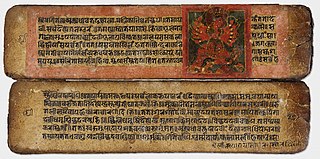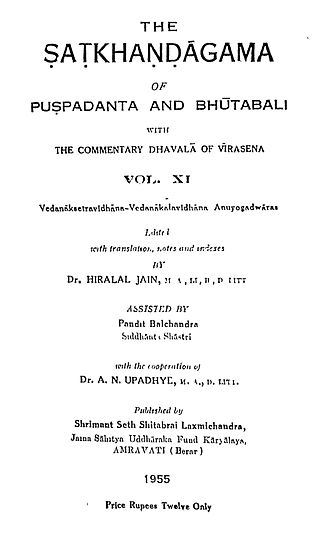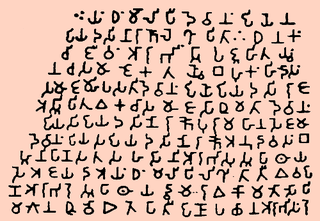
Sutra in Indian literary traditions refers to an aphorism or a collection of aphorisms in the form of a manual or, more broadly, a condensed manual or text. Sutras are a genre of ancient and medieval Indian texts found in Hinduism, Buddhism and Jainism.

Mahavira, also known as Vardhamana, was the 24th tirthankara of Jainism. He was the spiritual successor of the 23rd tirthankara Parshvanatha. Mahavira was born in the early part of the 6th century BCE into a royal Kshatriya Jain family in ancient India. His mother's name was Trishala and his father's name was Siddhartha. They were lay devotees of Parshvanatha. Mahavira abandoned all worldly possessions at the age of about 30 and left home in pursuit of spiritual awakening, becoming an ascetic. Mahavira practiced intense meditation and severe austerities for twelve and a half years, after which he attained Kevala Jnana (omniscience). He preached for 30 years and attained Moksha (liberation) in the 6th century BCE, although the year varies by sect.

Sanskrit literature broadly comprises all literature in the Sanskrit language. This includes texts composed in the earliest attested descendant of the Proto-Indo-Aryan language known as Vedic Sanskrit, texts in Classical Sanskrit as well as some mixed and non-standard forms of Sanskrit. Literature in the older language begins with the composition of the Ṛg·veda between about 1500 and 1000 BCE, followed by other Vedic works right up to the time of the grammarian Pāṇini around 6th or 4th century BCE.
Hindu texts are manuscripts and voluminous historical literature which are related to any of the diverse traditions within Hinduism. A few of these texts are shared across these traditions and they are broadly considered Hindu scriptures. These include the Itihasa and Vedas. Scholars hesitate in defining the term "Hindu scriptures" given the diverse nature of Hinduism, but many list the Agamas as Hindu scriptures, and Dominic Goodall includes Bhagavata Purana and Yajnavalkya Smriti in the list of Hindu scriptures as well.
The Acharanga Sutra is the first of the twelve Angas, part of the agamas which were compiled based on the teachings of 24th Jina Mahavira.
Sūtrakṛtāṅga सूत्रकृताङ्ग is the second agama of the 12 main aṅgās of the Jain Svetambara canon. According to the Svetambara tradition it was written by Gandhara Sudharmasvami in Ardhamagadhi Prakrit.The text is in two main parts: the first in verse and the second in prose. It is written using techniques including narration and questions and answers, and the chapters start with Sudharmasvami explaining the various doctrines to his chief disciple Jambuswami and answering his questions.
Sthananga Sutra forms part of the first eleven Angas of the Jaina Canon which have survived despite the bad effects of this Hundavasarpini kala as per the Śvetāmbara belief. This is the reason why, under the leadership of Devardhigani Ksamasramana, the eleven Angas of the Svetambara canon were formalised and reduced to writing. This took place at Valabhi 993 years after Māhavīra's nirvana.. In the vacana held at Valabhi, in Gujarat, the Sthananga Sutra was finalised and redacted. The language used is Ardhamāgadhī Prakrit. The mula sutras of the Sthananga Sutra are difficult to understand without the help of a commentary or tika. Hence, in the 11th century CE, Abhayadevasuri wrote a comprehensive Sanskrit gloss on the Sthananga Sutra.

The Ṣaṭkhaṅḍāgama is the foremost and oldest Digambara Jain sacred text.
This article contains the index of articles related to Jainism.
Jainism is a religion founded in ancient India. Jains trace their history through twenty-four tirthankara and revere Shree Rishabhnatha Bhagwan as the first tirthankara. The last two tirthankara, the 23rd tirthankara Parshvanatha and the 24th tirthankara Mahavira are considered historical figures. According to Jain texts, the 22nd Tirthankara Neminatha lived about 5,000 years ago and was the cousin of Sri Krishna Bhagwaan.
Drstivāda is a legendary lost text in the Jain religion. It is the last of the 12 Jain āgamas as per Śvetámbara tradition, said to be promulgated by Māhavīra himself and composed by Ganadhara Sudharmaswami. Drstivāda, translated as “Disputation about views”, was said to contain the entire knowledge of the Fourteen Purvas or prior knowledge that is now considered to be totally lost, in part because the tradition holds that the Drstivāda itself is also completely lost. However, its contents have been referred and explained in Nandi and Samavāyānga Sūtra.
The Fourteen Purva translated as ancient or prior knowledge, are a large body of Jain scriptures that was preached by all Tirthankaras of Jainism encompassing the entire gamut of knowledge available in this universe. The persons having the knowledge of purvas were given an exalted status of Shrutakevali or "scripturally omniscient persons". Both the Jain traditions, Svetambara and Digambara hold that all the fourteen purvas have been lost. According to tradition, the Purvas were part of canonical literature and deposited in the third section of Drstivada. Knowledge of Purvas became fairly vulnerable after Mahavira's nirvana (liberation) and on account of effects of famine, such that, eventually only one person—Bhadrabahu Svami had a command over it. In accordance with the prophecy of Mahavira, the knowledge of Purvas died within 1,000 years of his nirvana and eventually, the whole of Drstivada disappeared as well.(Bhagvati Sutra 20.8) However, a detailed table of contents of the Drstivada and the Purvas has survived in the fourth Anga, Samavāyānga and Nandīsūtra. Furthermore, certain portions of Drstivada and Purvas is said to have survived in Satkhandāgama and Kasāyaprabhrta, especially the doctrine of Karma.
Jain literature refers to the literature of the Jain religion. It is a vast and ancient literary tradition, which was initially transmitted orally. The oldest surviving material is contained in the canonical Jain Agamas, which are written in Ardhamagadhi, a Prakrit language. Various commentaries were written on these canonical texts by later Jain monks. Later works were also written in other languages, like Sanskrit and Maharashtri Prakrit.

Jambuvijaya (1923–2009), also known as Muni Jambuvijayji Maharajsaheb, was a monk belonging to the Tapa Gaccha order of Svetambara sect of Jainism. He was known for his pioneering work in research, cataloguing and translations of Jain Agamas and ancient texts. He was responsible for discovering and publishing many ancient Jains texts lying in different forgotten Jain jnana bhandaras. He was a disciple of Muni Punyavijay. Both Muni Punyavijay and Jambuvijay worked all their life in the compilation and publication of ancient Jain Agama literature and cataloguing ancient Jain jnana bhandaras. Muni Jambuvijay was a scholar who devoted his entire life to critically editing Jain scriptures.
According to the Jain cosmology, the śalākapuruṣa "illustrious or worthy persons" are 63 illustrious beings who appear during each half-time cycle. They are also known as the triṣaṣṭiśalākāpuruṣa. The Jain universal or legendary history is a compilation of the deeds of these illustrious persons. Their life stories are said to be most inspiring.

Jainism is an Indian religion which is traditionally believed to be propagated by twenty-four spiritual teachers known as tirthankara. Broadly, Jainism is divided into two major schools of thought, Digambara and Svetambara. These are further divided into different sub-sects and traditions. While there are differences in practices, the core philosophy and main principles of each sect is the same.

Lipi means 'writing, letters, alphabet', and contextually refers to scripts, the art or manner of writing, or in modified form such as lipī (लिपी) to painting, decorating or anointing a surface to express something.
Early Buddhist texts (EBTs), early Buddhist literature or early Buddhist discourses are parallel texts shared by the early Buddhist schools. The most widely studied EBT material are the first four Pali Nikayas, as well as the corresponding Chinese Āgamas. However, some scholars have also pointed out that some Vinaya material, like the Patimokkhas of the different Buddhist schools, as well as some material from the earliest Abhidharma texts could also be quite early.
Vasudeva-hindi is a Jain text by Sangha-dasa, probably from 5th century India. The text narrates several stories in the form of nested narrative layers. The main story is borrowed from Gunadhya's Brihat-katha, with the original hero Nara-vahana-datta replaced by Krishna's father Vasudeva.








